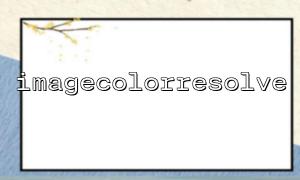In PHP, the imagecolorresolve() function is a very useful image processing function. It is used to parse a color in an image and convert it to a color index. Specifically, its function is to find out whether a color already exists based on the current color configuration of the image. If the color already exists, the index value of the color is returned; if it does not exist, false .
int imagecolorresolve(resource $image, int $red, int $green, int $blue);
$image : Image resource, created through functions such as imagecreate() or imagecreatefromjpeg() .
$red, $green, $blue : Three integer values representing the RGB component of the color, ranging from 0 to 255.
The return value of the imagecolorresolve() function is an integer indicating the color index of the color in the image. If the color exists in the image's color table, it returns the index value of the color (this index value is the index position of the image's color table). If the color does not appear in the image's color table, false is returned.
Assuming that the color value we passed in already exists in the image's color table, the function returns the index value of this color. In PHP, the index value of the color is represented by the image's color table (such as the color palette). A color palette is usually a collection of colors used when working with images. When we need to manipulate a color, we use the index of that color in the color table instead of using the RGB value directly.
For example:
$image = imagecreate(100, 100);
$red = imagecolorallocate($image, 255, 0, 0); // Create a red
$blue = imagecolorallocate($image, 0, 0, 255); // Create a blue color
$resolvedRed = imagecolorresolve($image, 255, 0, 0); // Find red
$resolvedBlue = imagecolorresolve($image, 0, 0, 255); // Find blue
$resolvedGreen = imagecolorresolve($image, 0, 255, 0); // Find green
echo "The red index is: $resolvedRed\n"; // Output red index
echo "The blue index is: $resolvedBlue\n"; // Output blue index
echo "The green index is: $resolvedGreen\n"; // Output false, Because green has not been allocated
In the above example, $resolvedRed and $resolvedBlue will return red and blue index values, while $resolvedGreen will return false because green has not been assigned in the image's color table.
When we call imagecolorresolve() , it checks the color table in the current image to see if the color we specified already exists. If the color exists in the image's color table, the function returns the index value of the color. These index values are an integer with a unique position in the image's color table.
If the color does not exist, false is returned, which means that the color has not been assigned to the image, possibly because the color was not used at the time of the image creation, or the color has been removed.
This is very useful when processing images, especially when we want to optimize color usage and reduce memory consumption. By reusing existing color indexes, the program can avoid repeatedly creating the same color, saving resources.
The imagecolorresolve() function is very useful in some scenarios where images need to be processed heavily, such as when dynamically generating images or performing image synthesis. If you have a large number of pixels of the same color to draw, check whether the color already exists, you can reduce the modification of the image color table and improve efficiency.
imagecolorresolve() is only suitable for palette images (such as .gif or .png formats), and not true color images (such as .jpg ).
If you need to create a new color without caring about whether it already exists, using imagecolorallocate() is more intuitive than imagecolorresolve() .
imagecolorresolve() is a useful function that helps us find colors that already exist in an image and avoid repeated creation of colors. Its return value can be the index value of the color or false , depending on whether the color already exists in the image's color table. By using this function reasonably, we can improve efficiency and optimize resource usage during image processing.














